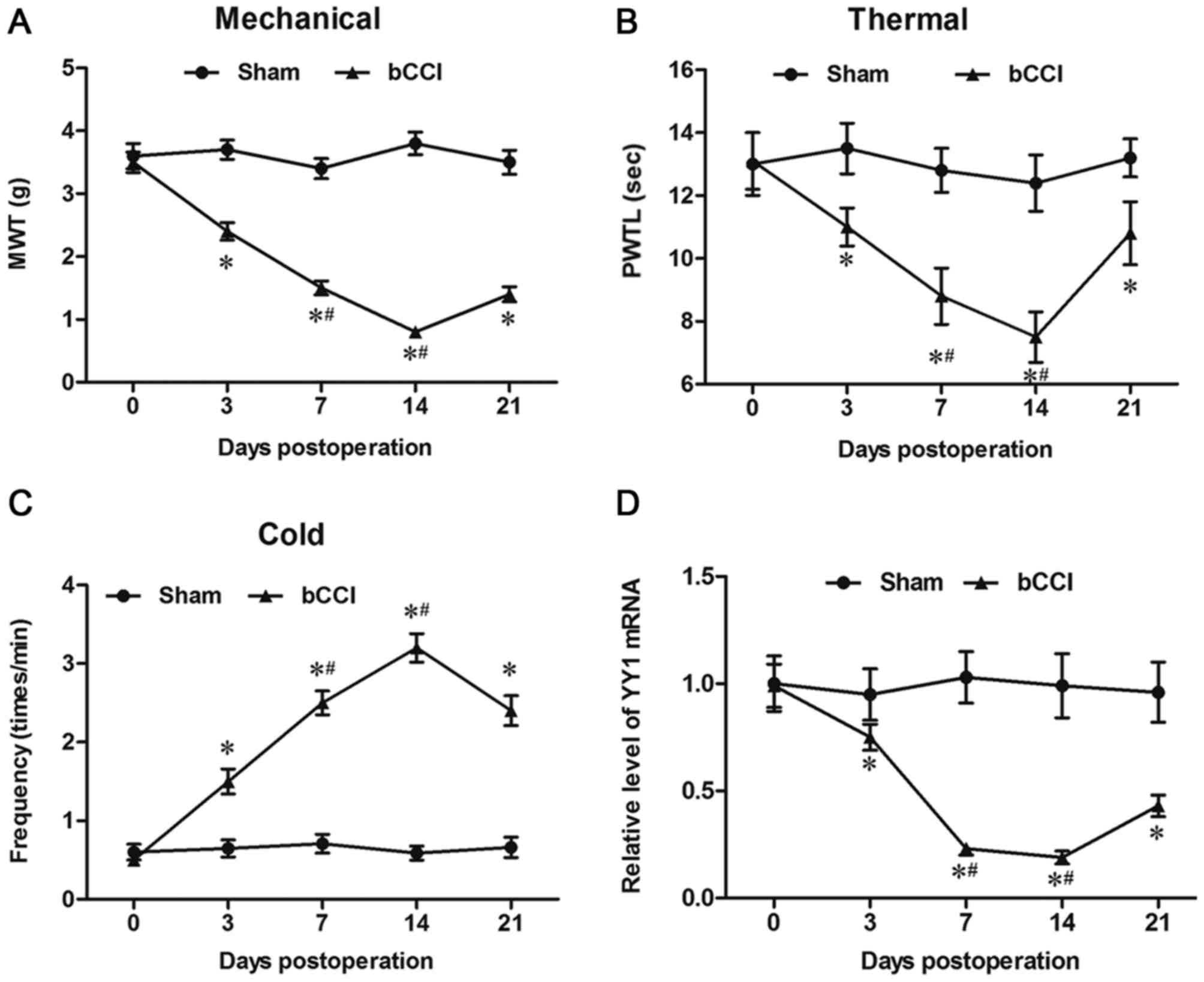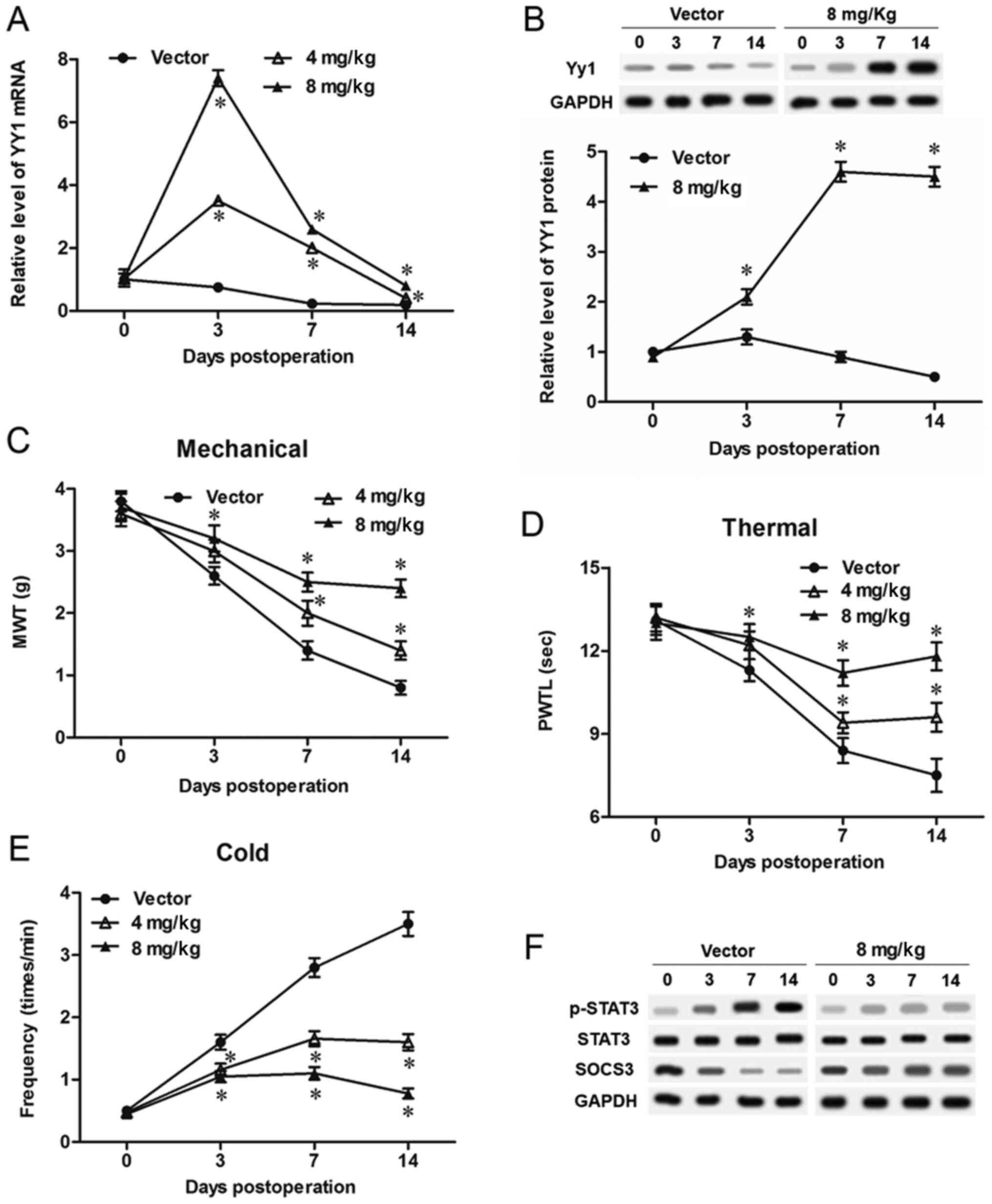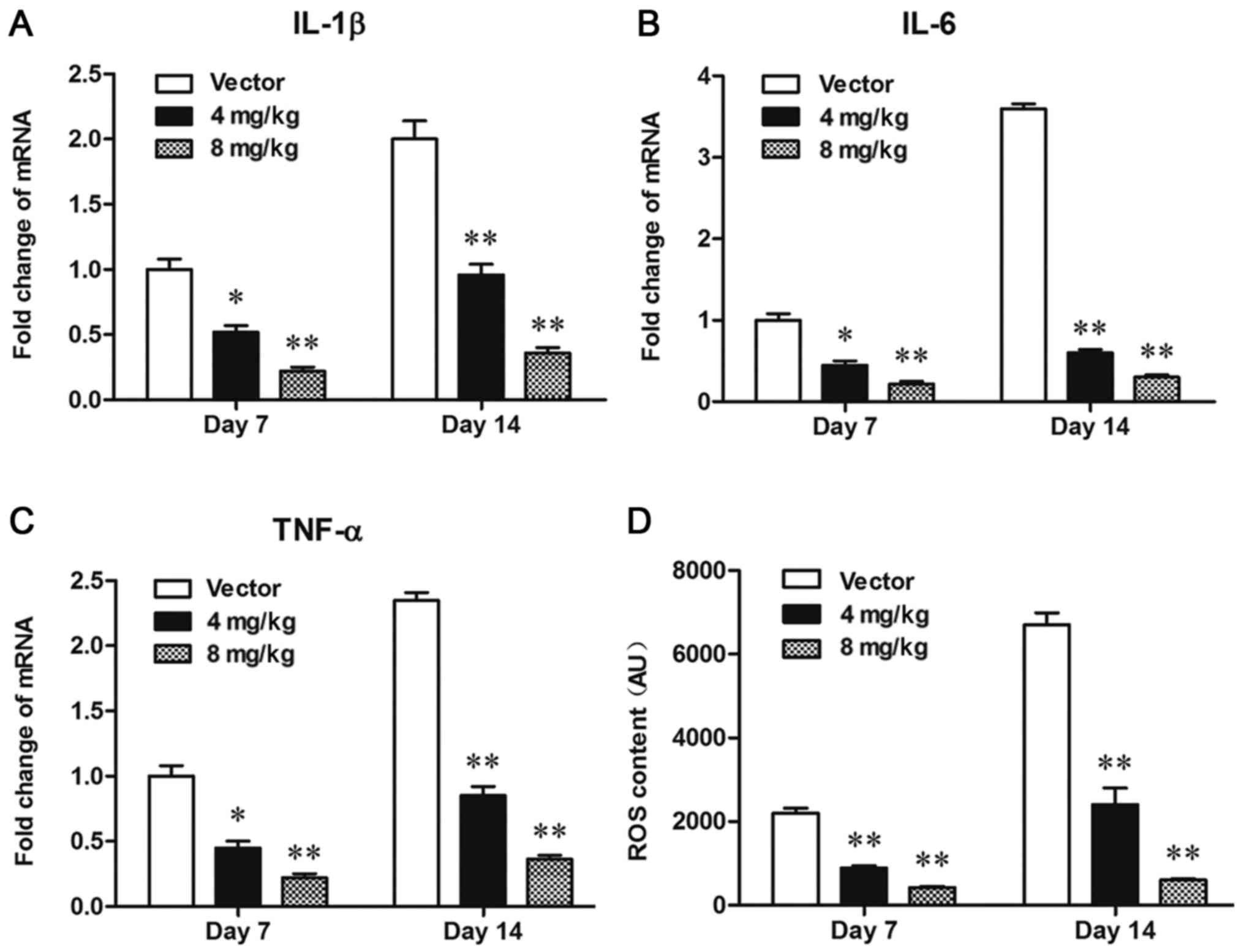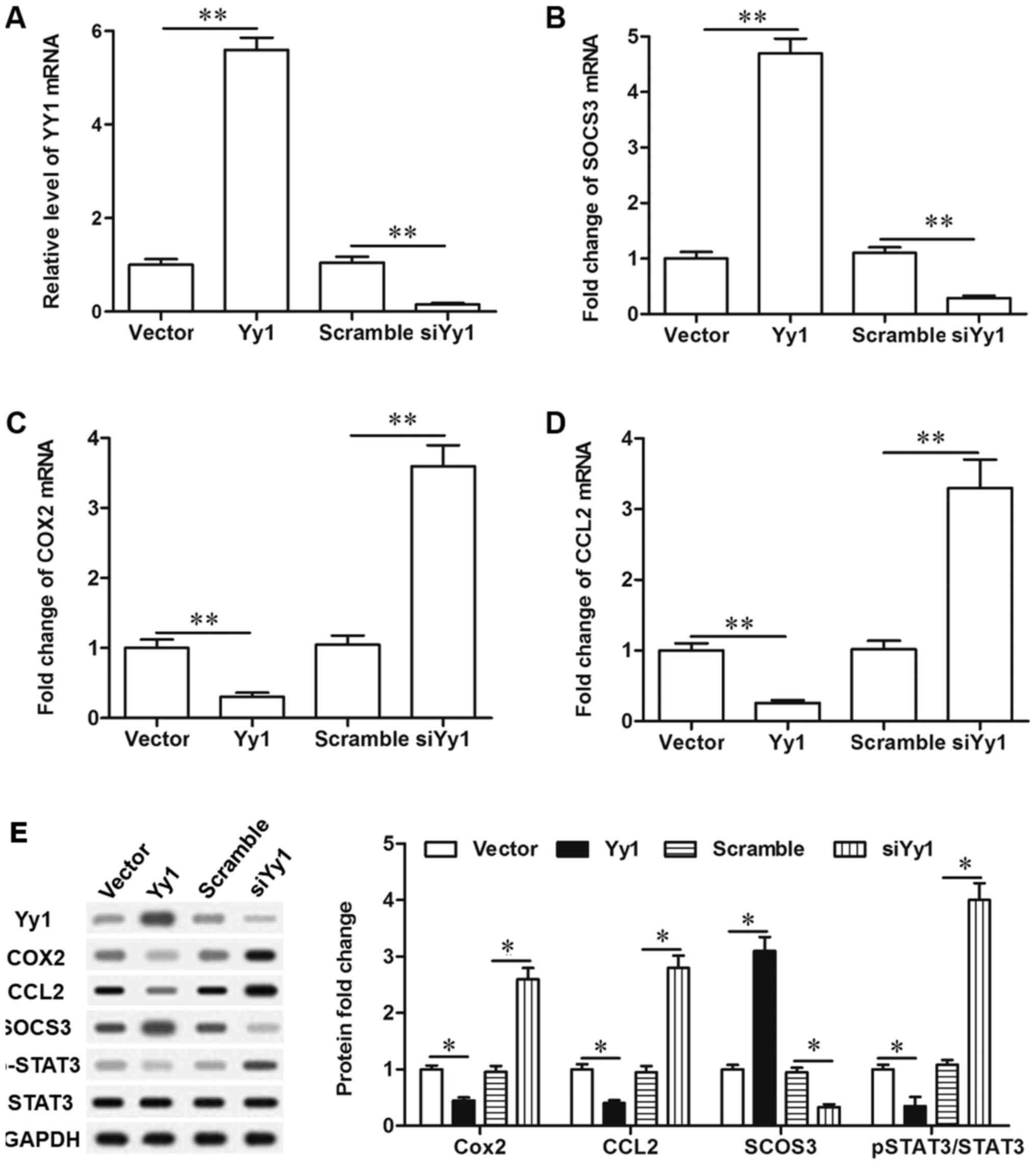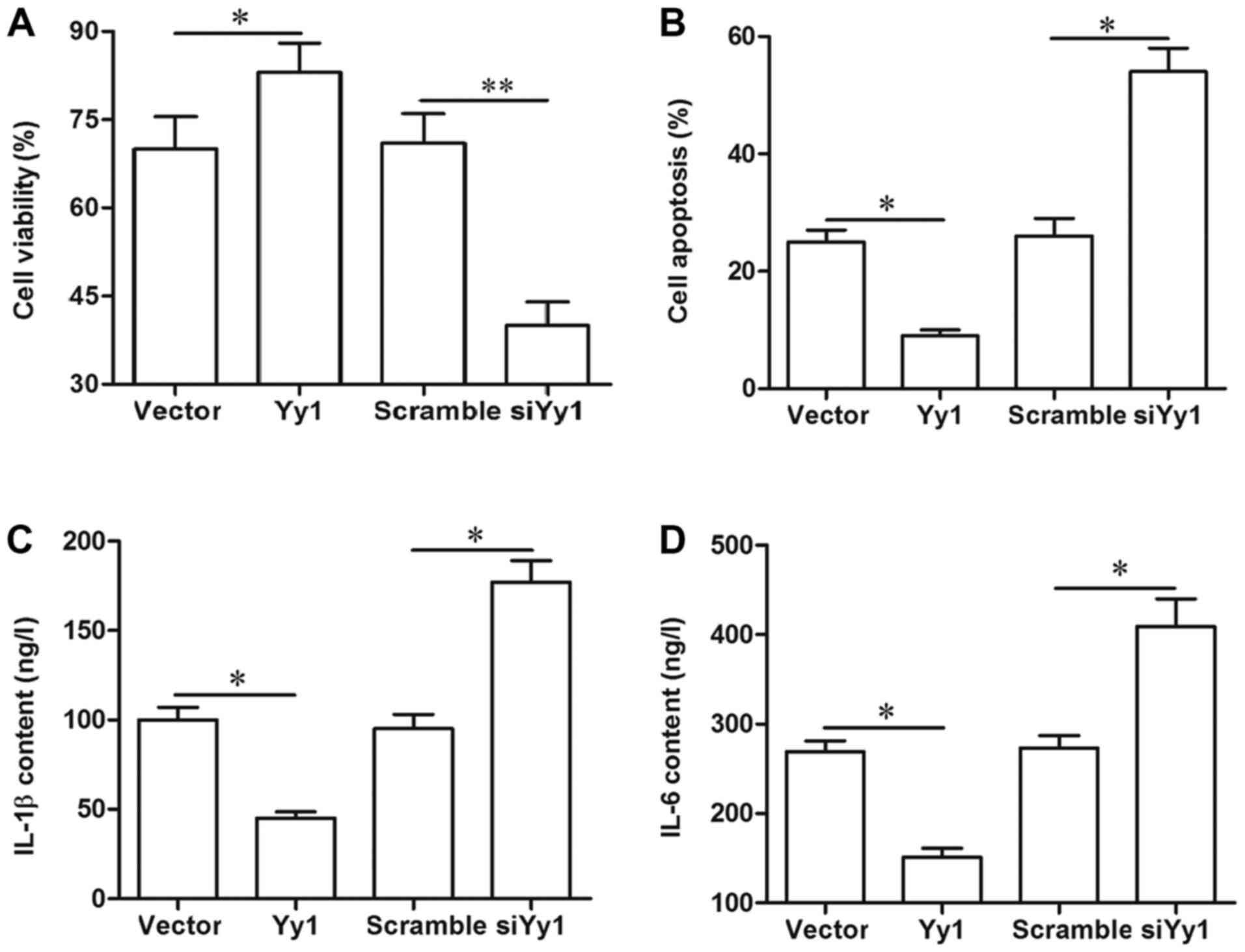|
1
|
Neville A, Peleg R, Singer Y, Sherf M and
Shvartzman P: Chronic pain: A population-based study. Isr Med Assoc
J. 10:676–680. 2008.
|
|
2
|
Yoshimura A, Naka T and Kubo M: SOCS
proteins, cytokine signalling and immune regulation. Nat Rev
Immunol. 7:454–465. 2007. View
Article : Google Scholar
|
|
3
|
Recio C, Oguiza A, Mallavia B, Lazaro I,
Ortiz-Muñoz G, Lopez-Franco O, Egido J and Gomez-Guerrero C: Gene
delivery of suppressors of cytokine signaling (SOCS) inhibits
inflammation and atherosclerosis development in mice. Basic Res
Cardiol. 110:82015. View Article : Google Scholar
|
|
4
|
Jo D, Liu D, Yao S, Collins RD and Hawiger
J: Intracellular protein therapy with SOCS3 inhibits inflammation
and apoptosis. Nat Med. 11:892–898. 2005. View Article : Google Scholar
|
|
5
|
Shi Y, Lee JS and Galvin KM: Everything
you have ever wanted to know about Yin Yang 1……. Biochim Biophys
Acta. 1332:F49–F66. 1997.
|
|
6
|
Sui G, Affar el B and Shi Y, Brignone C,
Wall NR, Yin P, Donohoe M, Luke MP, Calvo D, Grossman SR and Shi Y:
Yin yang 1 is a negative regulator of p53. Cell. 117:859–872. 2004.
View Article : Google Scholar
|
|
7
|
Guo J, Lin X, Williams MA, Hamid Q and
Georas SN: Yin-yang 1 regulates effector cytokine gene expression
and T(H)2 immune responses. J Allergy Clin Immunol. 122:195–201,
201.e1-e5. 2008. View Article : Google Scholar
|
|
8
|
Xue ZJ, Shen L, Wang ZY, Hui SY, Huang YG
and Ma C: STAT3 inhibitor WP1066 as a novel therapeutic agent for
bCCI neuropathic pain rats. Brain Res. 1583:79–88. 2014. View Article : Google Scholar
|
|
9
|
Soares Nda C, Teodoro AJ, Oliveira FL,
Santos CA, Takiya CM, Junior OS, Bianco M, Junior AP, Nasciutti LE,
Ferreira LB, et al: Influence of lycopene on cell viability cell
cycle and apoptosis of human prostate cancer and benign
hyperplastic cells. Nutr Cancer. 65:1076–1085. 2013. View Article : Google Scholar
|
|
10
|
Sánchez-Fidalgo S, da Silva MS, Cárdeno A,
Aparicio-Soto M, Salvador MJ, Frankland Sawaya AC, Souza-Brito AR
and de la Lastra CA: Abarema cochliacarpos reduces LPS-induced
inflammatory response in murine peritoneal macrophages regulating
ROS-MAPK signal pathway. J Ethnopharmacol. 149:140–147. 2013.
View Article : Google Scholar
|
|
11
|
Watkins LR and Maier SF: Immune regulation
of central nervous system functions: From sickness responses to
pathological pain. J Intern Med. 257:139–155. 2005. View Article : Google Scholar
|
|
12
|
Seiler F, Herr C, Lepper PM, Bals R and
Beisswenger C: FOXO transcription factors regulate innate immune
mechanisms in respiratory epithelial cells during bacterial
infection. American thoracic society 2012 international conference
may 18–23, 2012 • San Francisco, California. ppA42582012.
|
|
13
|
Lu SY, Rodriguez M and Liao WS: YY1
represses rat serum amyloid A1 gene transcription and is
antagonized by NF-kappa B during acute-phase response. Mol Cell
Biol. 14:6253–6263. 1994. View Article : Google Scholar
|
|
14
|
Yan X, Pan J, Xiao W, Cheng M, Sun Y,
Zhang S and Chen Y: Yin Yang 1 (YY1) synergizes with Smad7 to
inhibit TGF-β signaling in the nucleus. Sci China Life Sci.
57:128–136. 2014. View Article : Google Scholar
|
|
15
|
Rylski M, Amborska R, Zybura K,
Mioduszewska B, Michaluk P, Jaworski J and Kaczmarek L: Yin yang 1
is a critical repressor of matrix metalloproteinase-9 expression in
brain neurons. J Biol Chem. 283:35140–35153. 2008. View Article : Google Scholar
|
|
16
|
Yeh TS, Lin YM, Hsieh RH and Tseng MJ:
Association of transcription factor YY1 with the high molecular
weight notch complex suppresses the transactivation activity of
notch. J Biol Chem. 278:41963–41969. 2003. View Article : Google Scholar
|
|
17
|
Takasaki I, Kurihara T, Saegusa H, Zong S
and Tanabe T: Effects of glucocorticoid receptor antagonists on
allodynia and hyperalgesia in mouse model of neuropathic pain. Eur
J Pharmacol. 524:80–83. 2005. View Article : Google Scholar
|
|
18
|
Mao J: Central glucocorticoid receptor: A
new role in the cellular mechanisms of neuropathic pain. Rev
Neurosci. 16:233–238. 2005. View Article : Google Scholar
|
|
19
|
Lu Y, Xiong X, Wang X, Zhang Z, Li J, Shi
G, Yang J, Zhang H, Ning G and Li X: Yin yang 1 promotes hepatic
gluconeogenesis through upregulation of glucocorticoid receptor.
Diabetes. 62:1064–1073. 2013. View Article : Google Scholar
|
|
20
|
Bergad PL, Towle HC and Berry SA: Yin-yang
1 and glucocorticoid receptor participate in the Stat5-mediated
growth hormone response of the serine protease inhibitor 2.1 gene.
J Biol Chem. 275:8114–8120. 2000. View Article : Google Scholar
|
|
21
|
Wei N, Wang Y, Xu RX, Wang GQ, Xiong Y, Yu
TY, Yang GS and Pang WJ: PU.1 antisense lncRNA against its mRNA
translation promotes adipogenesis in porcine preadipocytes. Anim
Genet. 46:133–140. 2015. View Article : Google Scholar
|
|
22
|
Wu J, Zhao Z, Zhu X, Renn CL, Dorsey SG
and Faden AI: Cell cycle inhibition limits development and
maintenance of neuropathic pain following spinal cord injury. Pain.
157:488–503. 2016. View Article : Google Scholar
|
|
23
|
Sato KL, Johanek LM, Sanada LS and Sluka
KA: Spinal cord stimulation reduces mechanical hyperalgesia and
glial cell activation in animals with neuropathic pain. Anesth
Analg. 118:464–472. 2014. View Article : Google Scholar
|
|
24
|
Wang M, Liu C, Su Y, Zhang K, Zhang Y,
Chen M, Ge M, Gu L, Lu T, Li N, et al: miRNA-34c inhibits myoblasts
proliferation by targeting YY1. Cell Cycle. 16:1661–1672. 2017.
View Article : Google Scholar
|
|
25
|
Ramkumar C, Cui H, Kong Y, Jones SN,
Gerstein RM and Zhang H: Smurf2 suppresses B-cell proliferation and
lymphomagenesis by mediating ubiquitination and degradation of YY1.
Nat Commun. 4:25982013. View Article : Google Scholar
|
|
26
|
Lu S, Wang MS, Chen PJ, Ren Q and Bai P:
MiRNA-186 inhibits prostate cancer cell proliferation and tumor
growth by targeting YY1 and CDK6. Exp Ther Med. 13:3309–3314. 2017.
View Article : Google Scholar
|
|
27
|
Wang M, Zhi LI, Jinyu XU and Shanshan XU:
The inhibition of cell proliferation and invasion through miR-34a
regulating YY1 in human renal carcinoma cell. Lab Med. 27:635–640.
2012.
|
|
28
|
Riman S: Mechanisms regulating YY1
cleavage during apoptosis. Dissertations & Theses-Gradworks.
2011.
|
|
29
|
Yakovleva T, Kolesnikova L, Vukojević V,
Gileva I, Tan-No K, Austen M, Lüscher B, Ekström TJ, Terenius L and
Bakalkin G: YY1 binding to a subset of p53 DNA-target sites
regulates p53-dependent transcription. Biochem Biophys Res Commun.
318:615–624. 2004. View Article : Google Scholar
|
|
30
|
Reséndizmartínez J, Asbunbojalil J,
Huertayepez S and Vega M: Correlation of the expression of YY1 and
fas cell surface death receptor with apoptosis of peripheral blood
mononuclear cells and the development of multiple organ dysfunction
in children with sepsis. Mol Med Rep. 15:2433–2442. 2017.
View Article : Google Scholar
|
|
31
|
Trabucco SE, Gerstein RM and Zhang H: YY1
regulates the germinal center reaction by inhibiting apoptosis. J
Immunol. 197:1699–1707. 2016. View Article : Google Scholar
|
|
32
|
Nicolas CS, Mascia A, Bortolotto ZA,
Doherty A, Csaba Z, Fafouri A, Dournaud P, Gressens P, Collingridge
GL and Peineau S: The role of JAK-STAT signaling within the CNS.
JAKSTAT. 2:e229252013.
|
|
33
|
Planas AM, Gorina R and Chamorro A:
Signalling pathways mediating inflammatory responses in brain
ischaemia. Biochem Soc Trans. 34:1267–1270. 2006. View Article : Google Scholar
|
|
34
|
Cai QW, Li J, Li XQ, Wang JQ and Huang Y:
Expression of STAT3, MMP-1 and TIMP-1 in gastric cancer and
correlation with pathological features. Mol Med Rep. 5:1438–1442.
2012.
|
|
35
|
Matsukawa A, Kudo S, Maeda T, Numata K,
Watanabe H, Takeda K, Akira S and Ito T: Stat3 in resident
macrophages inflammatory response. J Immunol. 175:3354–3359. 2005.
View Article : Google Scholar
|
|
36
|
Kiguchi N, Saika F, Kobayashi Y, Ko MC and
Kishioka S: TC-2559, an α4β2 nicotinic acetylcholine receptor
agonist, suppresses the expression of CCL3 and IL-1β through STAT3
inhibition in cultured murine macrophages. J Pharmacol Sci.
128:83–86. 2015. View Article : Google Scholar
|
|
37
|
Rummel C, Sachot C, Poole S and Luheshi
GN: Circulating interleukin-6 induces fever through a STAT3-linked
activation of COX-2 in the brain. Am J Physiol Regul Integ Comp
Physiol. 291:R1316–R1326. 2006. View Article : Google Scholar
|
|
38
|
Aid S, Langenbach R and Bosetti F:
Neuroinflammatory response to lipopolysaccharide is exacerbated in
mice genetically deficient in cyclooxygenase-2. J
Neuroinflammation. 5:1–14. 2008. View Article : Google Scholar
|
|
39
|
Li L and Zhao G: Downregulation of
microRNA-218 relieves neuropathic pain by regulating suppressor of
cytokine signaling 3. International J Mol Med. 37:851–858. 2016.
View Article : Google Scholar
|
|
40
|
Croker BA, Krebs DL, Zhang JG, Wormald S,
Willson TA, Stanley EG, Robb L, Greenhalgh CJ, Förster I, Clausen
BE, et al: SOCS3 negatively regulates IL-6 signaling in vivo. Nat
Immunol. 4:540–545. 2003. View
Article : Google Scholar
|
|
41
|
Xiang-Mei YU, Yang YZ, Liu JB, Chang-Zheng
LI, Gong DG and Wang ZF: Effects of warming acupuncture therapy on
expressions of IL-6 and SOCS3 in spinal cord in rats with
neuropathic pain. Chin J Inform Tradit Chin Med. 2018.
|















